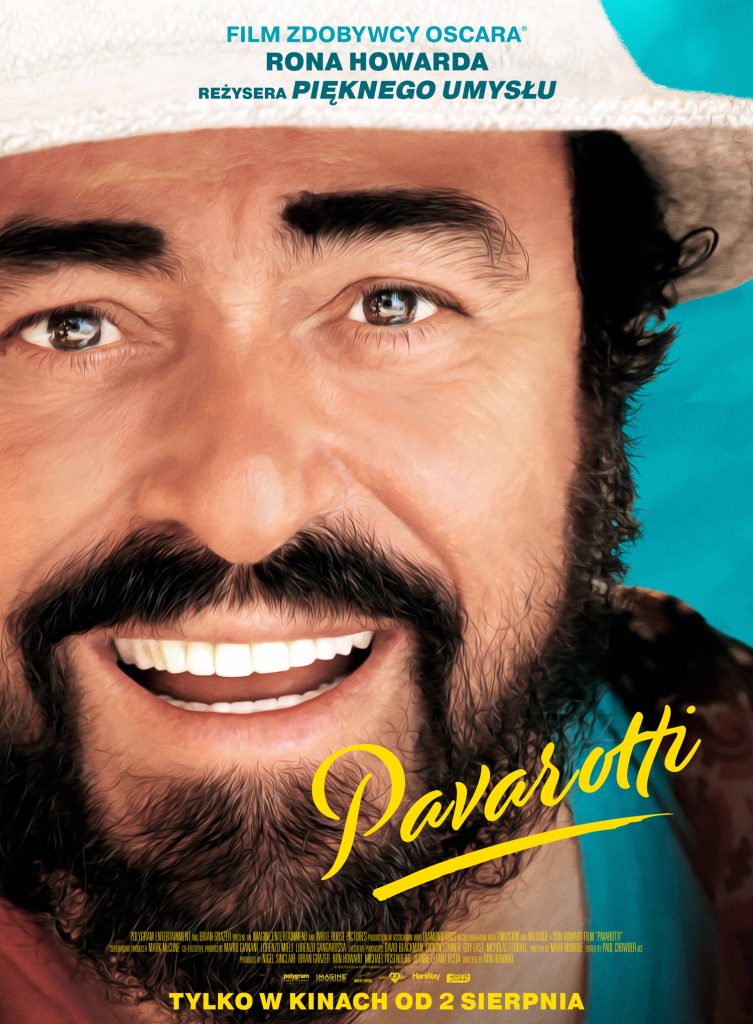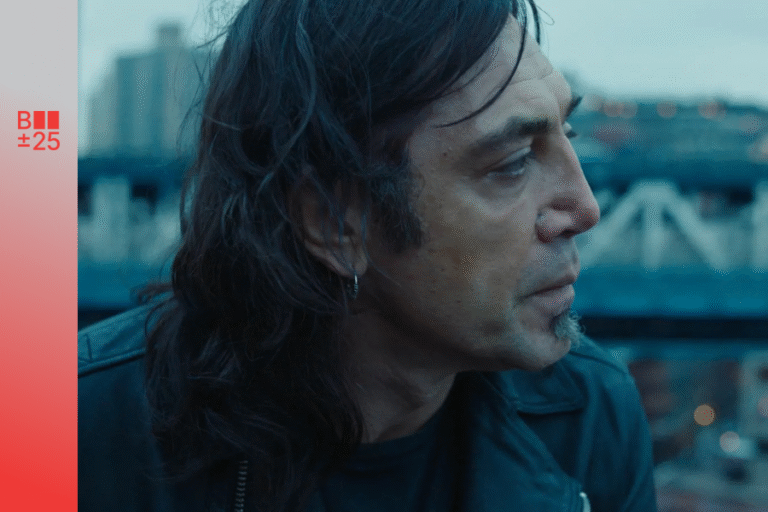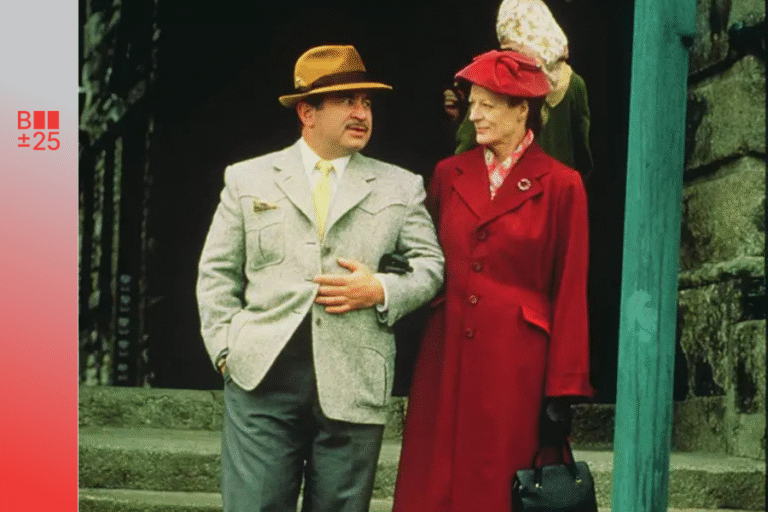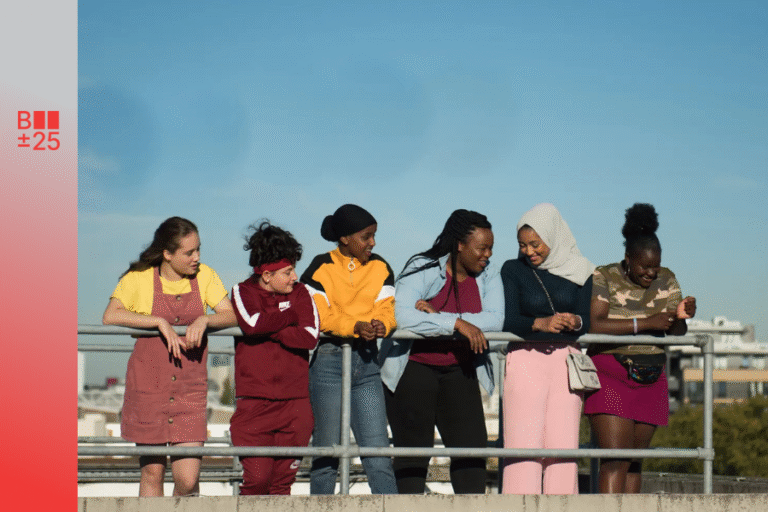
Pavarotti: prawdziwa gwiazda rocka w operowych wydaniu, nieziemski głos, wspaniały człowiek, legenda. Tylko on mógł nakłonić lady Dianę do tego, by słuchała go moknąc w deszczu, tylko on jeździł po świecie z własnym jedzeniem, wiadomo – Włoch!
Film zawiera nagrania niezapomnianych występów, w tym fragmenty z koncertu Trzech Tenorów oraz nigdy wcześniej niepublikowane materiały archiwalne i wypowiedzi najbliższych, w tym drugiej żony Pavarottiego – Nicoletty, a także Jose Carrerasa, Placido Domingo i frontmana U2 Bono.
PL
Od pierwszych ujęć w krótkich filmach Sally Potter widać, że gest i ruch odgrywają niezwykle ważną rolę w budowaniu znaczenia, a szacunek dla wolności artystycznej stanowi fundament jej twórczości. Już w JERK - filmie, który stworzyła mając zaledwie 20 lat - Sally Potter testuje granice filmu, łącząc twarze w dynamiczny montaż i obserwując gesty mężczyzny, którego widzimy na ekranie, a nawet zwykłe otwierające się okno staje się nośnikiem znaczeń dzięki eksperymentalnemu podejściu do rejestracji obrazu. Ta wrażliwość wobec ruchu, przestrzeni i rytmu osiąga pełnię w HORS D’OUVRES, w którym łączy materiały na taśmie 8 mm i 16 mm, wyświetlając je na szkle i rejestrując ponownie. Te zmieniają percepcję widza - światło prowadzi wzrok, a każdy ruch tancerzy zyskuje nową głębię przy kolejnym spojrzeniu.
W filmach Sally Potter czuć zaufanie do widza - wierzy, że potrafi dostrzec odniesienia, wyłapać znaczenia, a jednocześnie pozwala odbiorcy poczuć i interpretować obraz po swojemu. To podejście staje się szczególnie wyraźne w PLAY, w ktorym obserwujemy grupę bawiących się dzieci. Jednak dzięki zastosowaniu split screenu, charakterystycznej ścieżki dźwiękowej, doboru kolorów, film podważa niewinność tej sceny. Zaczynamy doszukiwać się głębszych warstw i kontekstów. PLAY bawi się naszą percepcją, i zdaje się być studium samego aktu bycia obserwowanym, i tego, jak warstwy filmowego języka mogą prowadzić tę obserwację w wielu, zaskakujących kierunkach. Podobną świadomość i precyzję pracy z przestrzenią, kolorem i montażem Potter prezentuje w jej ostatnim filmie LOOK AT ME. Napięcie między Javierem Bardemem a Chrisem Rockiem tworzy dynamiczną grę sił i charakterów, ambicji i ego, artystycznej wolności i partnerskiego wsparcia, osadzoną w przestrzeni precyzyjnie ukształtowanej pod kątem emocjonalnych i psychologicznych relacji między bohaterami.
Ta otwartość na eksperyment łączy się u Sally Potter z wyraźną świadomością kontekstu społecznego i politycznego, co widać zarówno w krótkich, jak i w pełnometrażowych filmach. W filmie THRILLER reinterpretacja historii Mimi z Cyganerii Pucciniego nadaje bohaterce sprawczość i podmiotowość, kwestionując mizoginiczny obraz kobiety, której los w opowieści prowadzi nieuchronnie do śmierci. Film pokazuje znacznie więcej: jej wątpliwości, jej emocje, i nareszcie - jej perspektywę własnego życia. W THE LONDON STORY, szpiegowski thriller przekształca się w grę absurdów i groteskowych sytuacji, gdzie scena tanga przy muzyce Romeo and Juliet Prokofiewa staje się zarówno wizualnym symbolem absurdu, jak i subtelnym komentarzem do polityki Wielkiej Brytanii lat 80.
Krótki metraż ma ten ogromny przywilej: pozwala na eksplorowanie kina wolnego od budżetowej presji, producenckich wymagań i box office’owych przechwałek. W twórczości tak nieustępliwej i kierującej się niezwykłą ciekawością formalną artystki jak Sally Potter, ten format odsłania się w szczególnie interesujący sposób, pokazując, jak odważnie można przekraczać przyjęte konwencje i rozwijać artystyczną oraz narracyjną wizję.
ENG
From the very first shots in Sally Potter's short films, it is clear that gesture and movement play an extremely prominent role in constructing meaning, and the respect for artistic freedom is the foundation of her work. Already in JERK, a film she made when she was only 20, she is pushing at the edges of cinema, splicing faces into dynamic editing, dwelling on the gestures of a man on screen, and even imbuing the simple opening of a window with layers of significance through an experimental play with image-making. This sensitivity to movement, space and rhythm reaches its peak in HORS D'OUVRES, where she combines 8 mm and 16 mm footage, projecting it onto glass and re-recording it. These change the viewer's perception: the light guides the eye, and each movement of the dancers gains new depth with each subsequent glance.
Sally Potter’s work is built on trust in her audience – the belief that they can catch references, tease out meanings, yet also feel and interpret freely in their own way. That becomes especially striking in PLAY, which on the surface follows a group of children at play. Yet through split-screen, a distinctive soundtrack and carefully chosen colours, Potter undermines the supposed innocence of the scene. The film nudges us to look for hidden layers and subtexts. PLAY toys with perception itself, becoming a study of what it means to be observed, and how the layers of cinematic language can steer that observation in multiple, often surprising directions. That same precision and awareness of space, colour and montage is at work in her most recent short, LOOK AT ME. The charged dynamic between Javier Bardem and Chris Rock unfolds as a power play of ego and ambition, freedom and collaboration, staged in a space meticulously calibrated to the emotional and psychological relations between its characters.
Potter’s openness to experiment is inseparable from her sharp sense of social and political context, evident across both her shorts and features. In THRILLER, Puccini’s Mimi from La Bohème is reimagined with agency and subjectivity, dismantling the misogynistic framing of a woman fated only for death. Potter grants her doubts, her emotions, and at last, her own perspective on life. Meanwhile, THE LONDON STORY twists the spy thriller into a farce of absurd and grotesque encounters, where a tango sequence set to Prokofiev’s Romeo and Juliet works both as a deliriously visual joke and a sly commentary on 1980s British politics.
Short films have this enormous privilege: they allow cinema to be explored free from the pressures of budgets, producers and box-office demands. In the hands of an artist as relentless and driven by extraordinary formal curiosity as Sally Potter, this format compellingly reveals itself, showing how boldly one can transcend accepted conventions and develop an artistic and narrative vision.
PL
Pełna taktu, elegancko opowiedziana i rozdzierająca adaptacja powieści Briana Moore’a opublikowanej w 1955 roku, kiedy autor miał 27 lat. Maggie Smith wciela się w tytułową bohaterkę: dojrzałą nauczycielkę muzyki, która poświęciła dużą część życia na opiekę nad chorą ciotką, a teraz musi ułożyć się z własną samotnością. Judith Hearne „ma klasę” – mówi w filmie James Madden (Bob Hoskins), który dzieli z nią ten sam dom z pokojami na wynajem w Dublinie. To prawda, ale jej nienaganne maniery i afektacja to maska dla cichej rozpaczy sprawiającej, że kobieta chętnie sięga po butelkę. W latach 50., kiedy dzieje się akcja filmu, niemłoda singielka postrzegana jest już jako „stara panna”. Judith wydaje się jednak wznosić ponad te uprzedzenia i pragnie nawiązać z Jamesem bliższą, być może romantyczną relację.
Droga powieści Moore’a na ekran była długa. Do ekranizacji przymierzał się John Huston, widzący w głównej roli Katharine Hepburn, oraz Irvin Kershner, którego wyborem była Deborah Kerr. Powstanie THE LONELY PASSION OF JUDITH HEARNE zawdzięczamy HandMade Films i jednemu z jej założycieli, eks-Beatlesowi George’owi Harrisonowi. W latach 80. firma wyprodukowała szereg nietuzinkowych filmów, na czele z pokazywanym w tej sekcji A PRIVATE FUNCTION oraz kultową komedią WITHNAIL & I
Tonacja dramatu Jacka Claytona jest jednak zupełnie inna. Dzięki mistrzowskiej, głęboko odczutej, zdumiewająco precyzyjnej i przekonującej roli Maggie Smith pokiereszowany świat emocjonalny Judith Hearne ożywa na naszych oczach: wraz z całą melancholią, pasją i ukrytą siłą doświadczanej przez los bohaterki. Za swoją rolę Smith otrzymała kolejną nagrodę BAFTA.
ENG
A poised, elegantly told and deeply affecting adaptation of Brian Moore’s 1955 novel, written when the author was just twenty-seven. Maggie Smith plays the title character, a middle-aged piano teacher who has devoted much of her life to caring for her ailing aunt and must now confront her own solitude. “She’s a lady”, remarks James Madden (Bob Hoskins), a fellow lodger in the Dublin boarding house they share - and he’s right. But Judith’s immaculate manners and genteel affectations barely conceal a quiet despair that drives her to the bottle. In 1950s Ireland, a single woman of her age is regarded as a spinster, yet Judith seems determined to rise above such narrow judgments, hoping that her bond with James might blossom into something more.
The novel’s journey to the screen was a long one. Both John Huston, who imagined Katharine Hepburn in the lead, and Irvin Kershner, who preferred Deborah Kerr, considered adapting it. The film finally came to life thanks to HandMade Films (co-founded by former Beatle George Harrison) which in the 1980s produced a remarkable string of British gems, including A PRIVATE FUNCTION and the cult classic WITHNAIL & I.
Jack Clayton’s film, however, strikes a very different tone. Through Maggie Smith’s masterly, deeply felt and astonishingly precise performance, Judith Hearne’s bruised emotional world unfolds before us - suffused with melancholy, longing and quiet resilience. For her extraordinary portrayal, Smith deservedly received another BAFTA award.
PL
Sarah Gavron zrobiła film wspólnotowy: zaprosiła do współpracy niemalże same kobiety i nastoletnie dziewczyny, by w toku warsztatów i improwizacji wypracować niezwykle czuły, witalny, a przy tym dramatyczny portret dziewczyńskiego dojrzewania – wśród przyjaciółek, które stają się oparciem w najgorszych momentach życia.
Rocks to ksywka Sholi, piętnastolatki ze wschodniego Londynu, która pewnego dnia musi się zmierzyć z nagłym odejściem pogrążonej w depresji matki. Zostaje sama, odpowiedzialna za siebie i młodszego brata, z drobnymi na podstawowe zakupy. Usilnie stara się zachować pozory normalności, dbać o szkołę, o codzienną rutynę. Sytuacja szybko jednak zaczyna ją przerastać. Po kilku nocach w domach koleżanek i w tanich hostelach, musi podjąć najtrudniejszą z decyzji.
Reżyserka nie korzysta jednak z klisz surowego realizmu społecznego. Polega na intensywności młodych aktorek i na energii dziewczyńskiej przyjaźni – mądrej, otwartej, wrażliwej. ROCKS serwuje też pulsujący życiem obraz rozmaitych kultur, z których wywodzą się bohaterki, na pierwszym miejscu stawia wspólnotę i unika jakiejkolwiek wiktymizacji. Podkreśla też niezwykłą moc solidarności. Nawet jeśli zakończenie filmu trudno nazwać happy endem, dzieło Gavron emanuje siłą, jaką daje wspólnota. To także rodzaj feministycznego manifestu – Rocks i jej przyjaciółki są silne i sprawcze, wystarczy im zaufać.
ENG
Sarah Gavron has created a truly collective film, collaborating almost exclusively with women and teenage girls, developing - through workshops and improvisation - an extraordinarily tender, vital and deeply moving portrait of girlhood and coming of age, where friendship becomes a lifeline in the darkest moments.
Rocks is the nickname of Shola, a fifteen-year-old from East London who suddenly finds herself alone after her mother, struggling with depression, abandons the family. Now left with her younger brother and only a few coins for groceries, she does her best to maintain appearances: she goes to school, keeping up a daily routine. Soon, the situation becomes impossible to manage. After several nights spent at friends’ houses and in cheap hostels, she must make an agonising decision.
Gavron steers clear of the clichés of grim social realism. Instead, she relies on the raw intensity of her young cast and the vibrant energy of female friendship – wise, open and emotionally attuned.
ROCKS also presents a vibrant picture of the diverse cultures from which the protagonists originate, prioritising community and avoiding any victimisation. It highlights the transformative power of solidarity. Even if its ending is far from a fairy-tale one, Gavron’s film radiates the strength that comes from togetherness. It is, in many ways, a feminist statement: Rocks and her friends are resilient and capable – they only need to be trusted.
Oko obiektywu uważnie przygląda się pomieszczeniu. Suto zastawiony stół, a przy nim ani żywego ducha. Przygotowane potrawy ledwo ruszone. Stłuczone szkło na podłodze. Wszystko wskazuje na kłótnię. O co poszło? Maddie (Rosamund Pike) i jej męża Franka (Matthew Rhys) budzi telefon. Jest środek nocy. Dzwoni Alice (Megan McDonnell), ich córka. Z przerażeniem w głosie wyznaje, że właśnie spowodowała wypadek. Nie jest dobrze. Osoba, którą potrąciła, nie oddycha. Kobieta i mężczyzna natychmiast wsiadają do auta. Jadą do niej. Proszą jedynaczkę, żeby się nie rozłączała. Po drodze zastanawiają się, co robić. Ona, doświadczona ratowniczka medyczna, sugeruje, że trzeba powiadomić służby. On oznajmia, że jest gotów wziąć winę na siebie. Kolejna sprzeczka wisi w powietrzu. Kamera, która jeszcze niedawno z takim spokojem lustrowała ich dom, teraz pracuje na pełnych obrotach. Nie opuszcza samochodu. Jest bardzo blisko nich. Alice natomiast nie widać. Słychać ją, ale to, czego doświadcza, rozgrywa się poza kadrem. Napięcie rośnie z każdą minutą. Zegar tyka. Czas akcji zostaje zrównany z czasem ekranowym. Jak długo można pokonywać kilka kilometrów? HALLOW ROAD (2025) Babaka Anvariego, brytyjskiego reżysera o irańskich korzeniach, to kino, w którym prosta z pozoru historia przekształca się w klaustrofobiczną opowieść o macierzyństwie i ojcostwie oraz ich granicach. Twórca, sięgając po dość odważny koncept, zadaje prowokacyjne pytanie o to, jak daleko posuną się rodzice, by zapewnić bezpieczeństwo swoim dzieciom, a także o to, w jakim stopniu różnice zdań pomiędzy nimi wpływają na przyszłość potomstwa.
ENG
The camera’s eye studies the room in detail: a lavishly laid table, not a soul in sight. Plates barely touched, shards of glass scattered across the floor. Signs of an argument. But about what? A sudden call awakens Maddie (Rosamund Pike) and her husband Frank (Matthew Rhys). It’s the middle of the night. On the other end of the line is their daughter Alice (Megan McDonnell). Her voice trembles as she admits she’s been in an accident. It doesn’t sound good - the person she hit isn’t breathing. The couple immediately get in the car. They tell their only child to stay on the line. On the way, they argue about what to do. She, an experienced paramedic, insists they must call the authorities. He says he’s ready to take the blame himself. Another row hangs in the air.
The camera, which only moments earlier lingered calmly over their home, now moves restlessly. It never leaves the car, staying uncomfortably close to them. Alice, on the other hand, is nowhere to be seen. We can only hear her voice as her ordeal unfolds off-screen. The tension rises with each passing minute. The clock is ticking, the film’s duration mirroring real time. How long can it take to drive just a few miles?
HALLOW ROAD (2025), directed by British-Iranian filmmaker Babak Anvari, transforms a seemingly simple storyline into a claustrophobic exploration of parenthood and its boundaries. Through a bold narrative concept, Anvari poses an unsettling question: how far will parents go to protect their child? And to what extent do their conflicting instincts shape that child’s future?



